The Intel 6th Gen Skylake Review: Core i7-6700K and i5-6600K Tested
by Ian Cutress on August 5, 2015 8:00 AM ESTGenerational Tests on the i7-6700K: Legacy, Office and Web Benchmarks
Moving on to the generational tests, and similar to our last Broadwell review I want to dedicate a few pages to specifically looking at how stock speed processors perform as Intel has released each generation. For this each CPU is left at stock, DRAM set to DDR3-1600 (or DDR4-2133 for Skylake in DDR4 mode) and we run the full line of CPU tests at our disposal.
Legacy
Some users will notice that in our benchmark database Bench, we keep data on the CPUs we’ve tested back over a decade and the benchmarks we were running back then. For a few of these benchmarks, such as Cinebench R10, we do actually run these on the new CPUs as well, although for the sake of brevity and relevance we tend not to put this data in the review. Well here are a few of those numbers too.

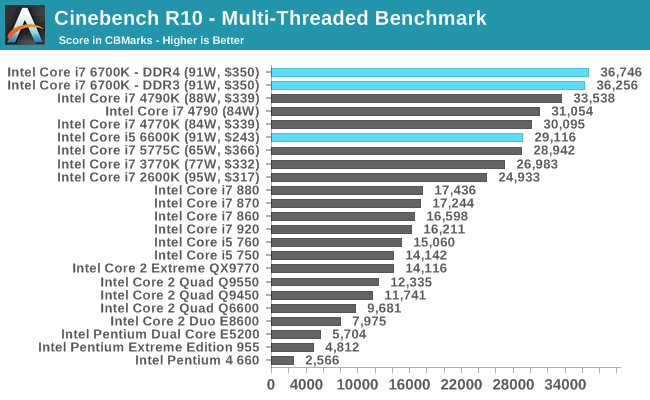


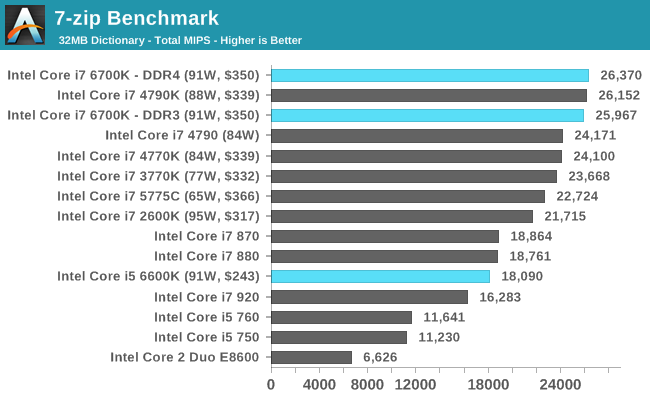
Even with the older tests that might not include any new instruction sets, the Skylake CPUs sit on top of the stack.
Office Performance
The dynamics of CPU Turbo modes, both Intel and AMD, can cause concern during environments with a variable threaded workload. There is also an added issue of the motherboard remaining consistent, depending on how the motherboard manufacturer wants to add in their own boosting technologies over the ones that Intel would prefer they used. In order to remain consistent, we implement an OS-level unique high performance mode on all the CPUs we test which should override any motherboard manufacturer performance mode.
Dolphin Benchmark: link
Many emulators are often bound by single thread CPU performance, and general reports tended to suggest that Haswell provided a significant boost to emulator performance. This benchmark runs a Wii program that raytraces a complex 3D scene inside the Dolphin Wii emulator. Performance on this benchmark is a good proxy of the speed of Dolphin CPU emulation, which is an intensive single core task using most aspects of a CPU. Results are given in minutes, where the Wii itself scores 17.53 minutes.
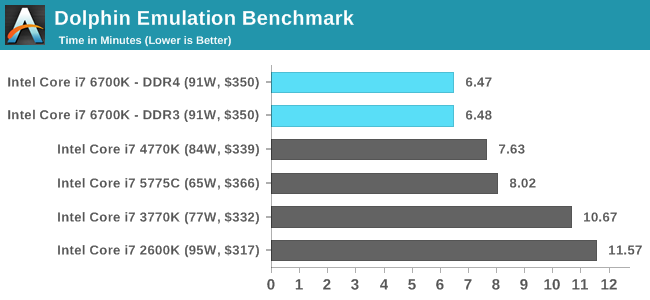
WinRAR 5.0.1: link
Our WinRAR test from 2013 is updated to the latest version of WinRAR at the start of 2014. We compress a set of 2867 files across 320 folders totalling 1.52 GB in size – 95% of these files are small typical website files, and the rest (90% of the size) are small 30 second 720p videos.

3D Particle Movement
3DPM is a self-penned benchmark, taking basic 3D movement algorithms used in Brownian Motion simulations and testing them for speed. High floating point performance, MHz and IPC wins in the single thread version, whereas the multithread version has to handle the threads and loves more cores.
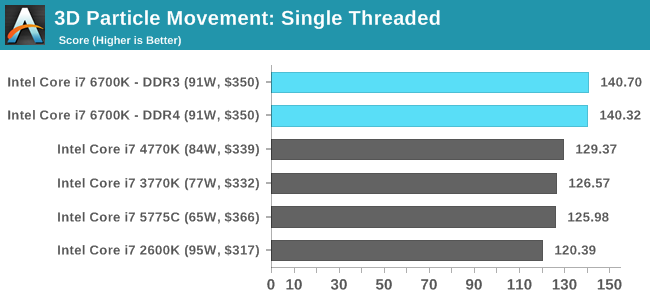
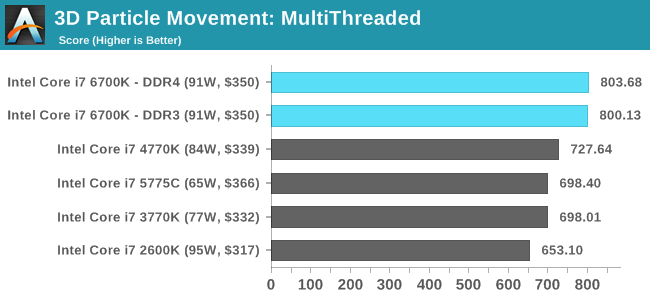
FastStone Image Viewer 4.9
FastStone is the program I use to perform quick or bulk actions on images, such as resizing, adjusting for color and cropping. In our test we take a series of 170 images in various sizes and formats and convert them all into 640x480 .gif files, maintaining the aspect ratio. FastStone does not use multithreading for this test, and results are given in seconds.
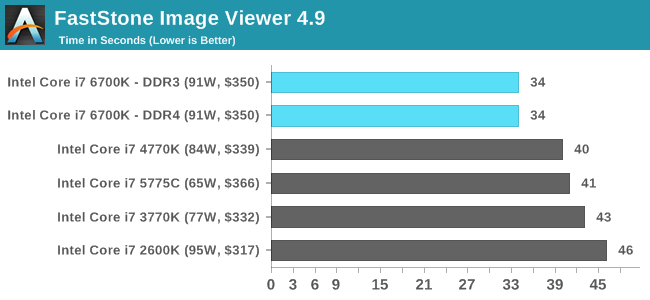
Web Benchmarks
On the lower end processors, general usability is a big factor of experience, especially as we move into the HTML5 era of web browsing. For our web benchmarks, we take four well known tests with Chrome 35 as a consistent browser.
Sunspider 1.0.2
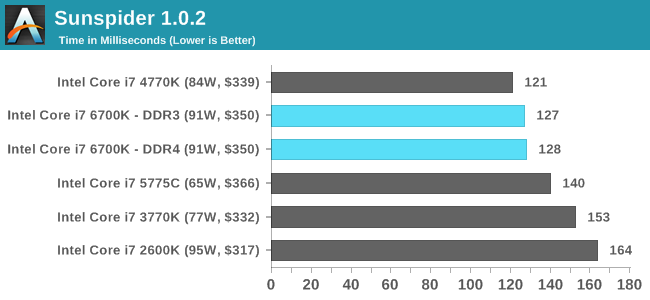
Mozilla Kraken 1.1
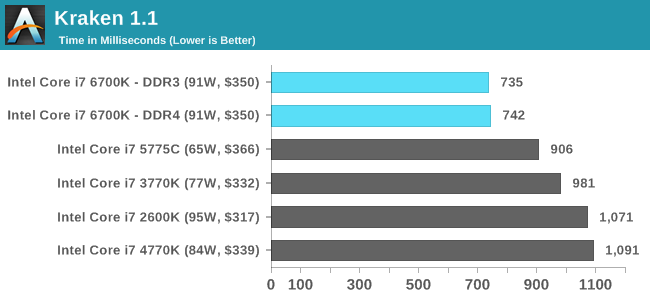
WebXPRT
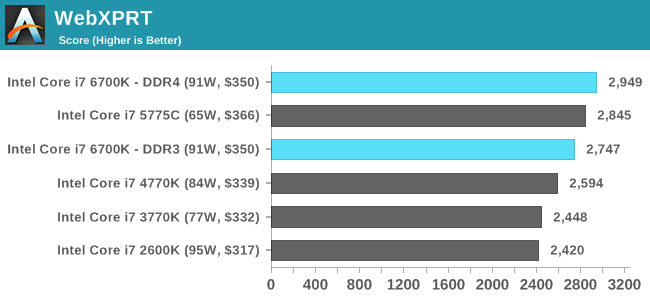
Google Octane v2
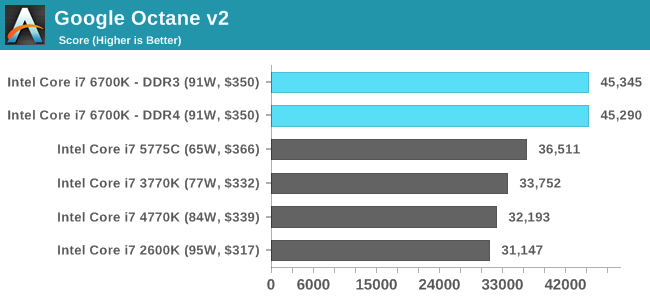










477 Comments
View All Comments
mkozakewich - Thursday, August 6, 2015 - link
It's unlikely you'll be seeing doubles and doubles anymore. If you look at what's been going on for the past several years, we're moving to more efficient processes instead of improving performance. I'm sure Intel's end goal is to make powerful CPUs for devices that fit into people's pockets. At that point you might see more start going into raw performance.edlee - Wednesday, August 5, 2015 - link
i am not sure why conclusion to the review makes it seem i7-2600k users should upgrade to this.If you are a gamer, there is no 25% improvement in average or minimum frame rate, its 3-6% at best.
Is this the future of intel's tock strategy, to give very little improvement to gamers?
VeauX - Wednesday, August 5, 2015 - link
On the gaming side, you'll never see a speed bump if you are not CPU Limited. Once you have a decent CPU, just put your money in GPU, period.Nagorak - Wednesday, August 5, 2015 - link
CPU is almost irrelevant for games at this point. As games start to take advantage of more cores, older processors are utilized more efficiently, further negating the need to upgrade. DX12 may improve this further.I sort of wonder if Intel isn't on a path to some trouble here. There's basically no point for anyone to upgrade their CPU anymore, not even gamers. Other than a few specialized applications the increase in performance just doesn't really matter, if it exists at all.
AndrewJacksonZA - Thursday, August 6, 2015 - link
I also sometimes think that, but then I remember that we developers *WILL* find a way to make use of more computing power.Having said that, I still can't quite justify me upgrading from my E6750 and 6670 @ 1240 x 1024. I slapped in an SSD in February last year and it was like I got a brand new machine.
Chrome and Edge on Win10 lag a teeny tiny bit though, maybe I can use that as my justification... Perhaps a 5960X or a 5930K though - more cores FTW? Or perhaps a 6700K and get it to 5GHz for the rights to claim some "5GHz Daily Driver" epeen... ;-)
Zoomer - Friday, August 14, 2015 - link
Exactly, I reached the opposite conclusion as Ian. There is no point in upgrading even from SB. If you do, stick to DDR3. Only GTA5 benefits from DDR4.It's interesting to see if regular DDR3 sticks can run on Skylake, perhaps by bumping the Vsa, voltages. Not clear if Ian's overclocking tests were with the IGP disabled - would be interesting to see if disabling the IGP / reducing Fgt, Vgt helps overclocking any.
StevoLincolnite - Wednesday, August 5, 2015 - link
I'm still happily sitting with my Sandy-Bridge-E. Still handles everything you could throw at it just fine... And still gives Intel's $1,000 chips a run for their money whilst sitting at 5Ghz.mapesdhs - Wednesday, August 12, 2015 - link
Yup, that's why my most recent gaming build was a R4E & 3930K, cost less than a new HW build, much quicker overall. My existing SB gaming PC is 5GHz aswell (every 2700K I've tried handles 5.0 just fine).leexgx - Monday, August 10, 2015 - link
hmm maybe i can upgrade from my i7-920 now (really any of the newer intel cpus are faster then it)sheeple - Thursday, October 15, 2015 - link
DON'T BE STUPID SHEEPLE!!! NEW DOES NOT ALWAYS = BETTER!